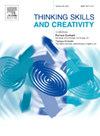Nurturing teachers’ creativity: Exploring leadership roles and constraints
IF 3.7
2区 教育学
Q1 Social Sciences
引用次数: 0
Abstract
Creativity research suggests the profound effect of leadership on the social environment that influences creativity within organisations. Despite numerous studies that claimed a role for leadership in nurturing creativity, the effects of instructional and innovative leadership on creativity development leading to organisational growth have remained largely overlooked. Therefore, this study examines the influence of leadership on teachers’ creativity. Data were collected from 369 teachers serving in secondary schools in Malaysia. In addition, three principals were also interviewed to understand how school leadership strategies can enhance teachers’ creativity within the school context. In addition, their challenges in supporting teachers’ creativity and innovation were explored. Results indicate that they mostly preferred instructional leadership rather than innovative leadership which aimed to influence their creativity. Findings from the structural model have confirmed that instructional leadership was the most preferred leadership practice compared to innovative leadership when enhancing teacher creativity. In exploring support for creativity, principals mainly used incentive and informal support and encouragement with teachers. In understanding principals’ constraints, senior teachers who are reluctant to change and principals’ heavy workloads and shortage of time are mentioned as challenges that principals need to face while supporting teachers’ creativity in schools. This study recommends that school leaders must possess sufficient knowledge and skill to support teachers’ creativity which requires that school leaders are open to and supportive of creative activities. The results also indicate that school leaders need to understand teachers’ requirements as providers of creative teaching and learning.
培养教师的创造力:探索领导角色和制约因素
创造力研究表明,领导力对影响组织内创造力的社会环境有着深远的影响。尽管有许多研究声称领导力在培养创造力方面发挥着作用,但教学和创新领导力对创造力发展从而促进组织成长的影响在很大程度上仍被忽视。因此,本研究探讨了领导力对教师创造力的影响。本研究收集了马来西亚 369 名中学教师的数据。此外,还采访了三位校长,以了解学校领导策略如何在学校环境中提高教师的创造力。此外,还探讨了他们在支持教师创造力和创新方面所面临的挑战。结果表明,他们大多倾向于教学领导,而不是旨在影响教师创造力的创新领导。结构模型的研究结果证实,在提高教师创造力方面,教学领导比创新领导更受青睐。在探索对教师创造力的支持方面,校长们主要采用激励和非正式的支持与鼓励。在了解校长的制约因素时,资深教师不愿改变、校长工作繁重和时间短缺被认为是校长在学校支持教师创造力时需要面对的挑战。本研究建议,学校领导必须具备足够的知识和技能来支持教师的创造性,这就要求学校领导对创造性活动持开放和支持的态度。研究结果还表明,学校领导需要了解教师作为创造性教学提供者的要求。
本文章由计算机程序翻译,如有差异,请以英文原文为准。
求助全文
约1分钟内获得全文
求助全文
来源期刊

Thinking Skills and Creativity
EDUCATION & EDUCATIONAL RESEARCH-
CiteScore
6.40
自引率
16.20%
发文量
172
审稿时长
76 days
期刊介绍:
Thinking Skills and Creativity is a new journal providing a peer-reviewed forum for communication and debate for the community of researchers interested in teaching for thinking and creativity. Papers may represent a variety of theoretical perspectives and methodological approaches and may relate to any age level in a diversity of settings: formal and informal, education and work-based.
 求助内容:
求助内容: 应助结果提醒方式:
应助结果提醒方式:


